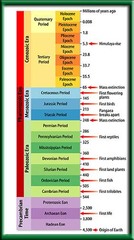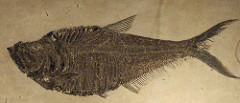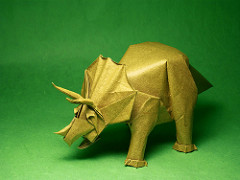Geologic Time and Fossils – Flashcards
Unlock all answers in this set
Unlock answersquestion
Paleontology
answer
he study of what fossils tell us about the ecologists of the past, about evolution, and about our place, as humans, in the world.
question
Geologic Time

answer
shows geologic events and life events
question
Fossil
answer
the remains or impression of a prehistoric organism preserved in petrified form or as a mold or cast in rock.
question
Precambrian
answer
largest span of time in Earth's history before the current Phanerozoic Eon, and is a Supereon divided into several eons of the geologic time scale.
question
Paleozoic

answer
major interval of geologic time that began 542 million years ago with the Cambrian explosion, an extraordinary diversification of marine animals, and ended 251 million years ago with the end-Permian extinction, the greatest extinction event in Earth history.
question
Mesozoic

answer
is an interval of geological time from about 252 to 66 million years ago. It is also called the age of reptiles,
question
Cenozoic
answer
which began about 65 million years ago and continues into the present, is the third documented era in the history of Earth. The current locations of the continents and their modern-day inhabitants, including humans, can be traced to this period.
question
Big Bang theory
answer
formation of universe (energy converted to matter) 14-20 BYA
question
Earth formation
answer
4.6 BYA
question
Eon-Era-Period-Epoch
answer
Geologic time is sorted like this
question
Cyano Bacteria
answer
preformed photosynthesis and produced the first oxygen
question
Pre- Cambrian
answer
1st BYA: no ocean or land- just chaos. -atmosphere developed- volcanic eruption (CO2)- life begins in ocean- 1st bacteria
question
Paleozoic
answer
age of fish, Jellyfish, and Amphibians
question
Mesozoic
answer
age of dinosaurs; extinction caused by asteroid collision
question
Cenozoic
answer
age of mammals; many ice ages
question
fossil record
answer
isn't complete due to W+E
question
steps of fossil formation
answer
organism dies- soft parts decompose/rot- bones and teeth are buried under sediment- remains replaced w/ minerals and turned into rock
question
mold fossil
answer
empty space left behind by an organism
question
cast fossil
answer
3d imprint of a fossil (fills in mold)
question
replaced remains
answer
hard parts of an organism replaced with minerals (petrified)
question
original remains
answer
actual remains still there (frozen in ice or amber)
question
trace fossil
answer
proof that an organism was there ( foot prints, coprolite, bite marks)
question
index fossil
answer
a fossils that helps scientists know about the life around a certain area in a given time
question
era
answer
subdivision of eons
question
eon
answer
two or more eras form this: the longest measure of geologic time
question
period
answer
two or more of these make an era
question
epoch
answer
sometimes periods are divided in this. The shortest measure of geologic time
question
relative age dating
answer
comparison of age
question
law of superposition
answer
rocks deeper in ground are older
question
absolute age dating

answer
actual age of something. found by using half life
question
radiometric dating
answer
is a technique used to date materials such as rocks or carbon, usually based on a comparison between the observed abundance of a naturally occurring radioactive isotope and its decay products, using known decay rates.
question
half life
answer
the time it takes for half the atoms to decay
question
Ordovician period
answer
best known for its diverse marine invertebrates, including graptolites, trilobites, brachiopods, and the conodonts (early vertebrates). A typical marine community consisted of these animals, plus red and green algae, primitive fish, cephalopods, corals, crinoids, and gastropods. More recently, tetrahedral spores that are similar to those of primitive land plants have been found, suggesting that plants invaded the land at this time.
question
Silurian period
answer
time when the Earth underwent considerable changes that had important repercussions for the environment and life within it. One result of these changes was the melting of large glacial formations. This contributed to a substantial rise in the levels of the major seas. The _____ witnessed a relative stabilization of the Earth's general climate, ending the previous pattern of erratic climatic fluctuations. Coral reefs made their first appearance during this time, and the _____ was also a remarkable time in the evolution of fishes. Not only does this time period mark the wide and rapid spread of jawless fish, but also the highly significant appearances of both the first known freshwater fish as well as the first fish with jaws. It is also at this time that our first good evidence of life on land is preserved, such as relatives of spiders and centipedes, and also the earliest fossils of vascular plants.
question
Triassic
answer
In many ways, the ______, lasting from 251.0 mya to 199.6 mya,* was a time of transition. It was at this time that the world-continent of Pangea existed, altering global climate and ocean circulation. The _______ also follows the largest extinction event in the history of life, and so is a time when the survivors of that event spread and recolonized. The organisms of the _______ can be considered to belong to one of three groups: holdovers from the Permo-______ extinction, new groups which flourished briefly, and new groups which went on to dominate the Mesozoic world. The holdovers included the lycophytes, glossopterids, and dicynodonts. While those that went on to dominate the ______ world include modern conifers, cycadeoids, and the dinosaurs.
question
Jurassic
answer
Great plant-eating dinosaurs roaming the earth, feeding on lush ferns and palm-like cycads and bennettitaleans ... smaller but vicious carnivores stalking the great herbivores ... oceans full of fish, squid, and coiled ammonites, plus great ichthyosaurs and long-necked plesiosaurs ... vertebrates taking to the air, like the pterosaurs and the first birds. This was the ____ Period, 199.6 to 145.5 million years ago* — a 54-million-year chunk of the Mesozoic Era. Named for the Jura Mountains on the border between France and Switzerland, where rocks of this age were first studied, the ______ has become a household word with the success of the movie ______ Park. Outside of Hollywood, the _________ is still important to us today, both because of its wealth of fossils and because of its economic importance — the oilfields of the North Sea, for instance, are _____ in age. The largest dinosaurs of the time — in fact, the largest land animals of all time — were the gigantic sauropods, such as the famous Diplodocus (top right, above), Brachiosaurus and Apatosaurus. Other herbivorous dinosaurs of the _______ included the plated stegosaurs. Predatory dinosaurs of the Jurassic included fearsome carnosaurs such as Allosaurus, small, fast coelurosaurs, and ceratosaurs such as Dilophosaurus. The _______ also saw the origination of the first birds, including the well-known Archaeopteryx, probably from coelurosaurian ancestors.
question
Cretaceous
answer
The ______ is usually noted for being the last portion of the "Age of Dinosaurs", but that does not mean that new kinds of dinosaurs did not appear then. It is during the ______ that the first ceratopsian and pachycepalosaurid dinosaurs appeared. Also during this time, we find the first fossils of many insect groups, modern mammal and bird groups, and the first flowering plants. The breakup of the world-continent Pangea, which began to disperse during the Jurassic, continued. This led to increased regional differences in floras and faunas between the northern and southern continents. The end of the _______ brought the end of many previously successful and diverse groups of organisms, such as non-avian dinosaurs and ammonites. This laid open the stage for those groups which had previously taken secondary roles to come to the forefront. The _______ was thus the time in which life as it now exists on Earth came together. No great extinction or burst of diversity separated the ______ from the Jurassic Period that had preceded it. In some ways, things went on as they had. Dinosaurs both great and small moved through forests of ferns, cycads, and conifers. Ammonites, belemnites, other molluscs, and fish were hunted by great "marine reptiles," and pterosaurs and birds flapped and soared in the air above. Yet the ______ saw the first appearance of many lifeforms that would go on to play key roles in the coming Cenozoic world. Perhaps the most important of these events, at least for terrestrial life, was the first appearance of the flowering plants, also called the angiosperms or Anthophyta. First appearing in the Lower _______ around 125 million years ago, the flowering plants first radiated in the middle ______, about 100 million years ago. Early angiosperms did not develop shrub- or tree-like morphologies, but by the close of the ________, a number of forms had evolved that any modern botanist would recognize. The angiosperms thrived in a variety of environments such as areas with damper climates, habitats favored by cycads and cycadeoids, and riparian zones. High southern latitudes were not invaded by angiosperms until the end of the ________. Ferns dominated open, dry and/or low-nutrient lands. Typical Jurassic vegetation, including conifers, cycads, and other gymnosperms, continued on into the Lower _______ without significant changes. At the beginning of this period, conifer diversity was fairly low in the higher latitudes of the Northern Hemisphere, but by the middle of the period, species diversification was increasing exponentially. Swamps were dominated by conifers and angiosperm dicots. At about the same time, many modern groups of insects were beginning to diversify, and we find the oldest known ants and butterflies. Aphids, grasshoppers, and gall wasps appear in the ______, as well as termites and ants in the later part of this period. Another important insect to evolve was the eusocial bee, which was integral to the ecology and evolution of flowering plants. The _________ also saw the first radiation of the diatoms in the oceans (freshwater diatoms did not appear until the Miocene).
question
The Cretaceous-Tertiary Extinction
answer
The most famous of all mass extinctions marks the end of the Cretaceous Period, about 65 million years ago. As everyone knows, this was the great extinction in which the dinosaurs died out, except for the birds, of course. The other lineages of "marine reptiles" — the ichthyosaurs, plesiosaurs, and mosasaurs — also were extinct by the end of the Cretaceous, as were the flying pterosaurs, but some, like the ichthyosaurs, were probably extinct a little before the end of the Cretaceous. Many species of foraminiferans went extinct at the end of the Cretaceous, as did the ammonites. But many groups of organisms, such as flowering plants, gastropods and pelecypods (snails and clams), amphibians, lizards and snakes, crocodilians, and mammals "sailed through" the Cretaceous-Tertiary boundary, with few or no apparent extinctions at all. What on Earth — or not — caused this extinction and how can we know? What killed the dinosaurs?
question
folding
answer
caused by compression of crustal plates
question
tilting
answer
caused by movement of crustal plates
question
strata
answer
layers of sedimentary rock in the ground
question
intrusion
answer
when magma enters rock layer (always younger than the rock it's in)
question
unconformity
answer
missing rock layer caused by W+E
question
fault
answer
break or shift in rock layers, causing earthquake; caused by moving crustal plates
question
cross section
answer
side view of rock layers
question
Youngest unconformity 31 lava flow b 30 intrusion 29 28 27 26 25 lava flow a 24 23
answer
List from oldest to youngest



